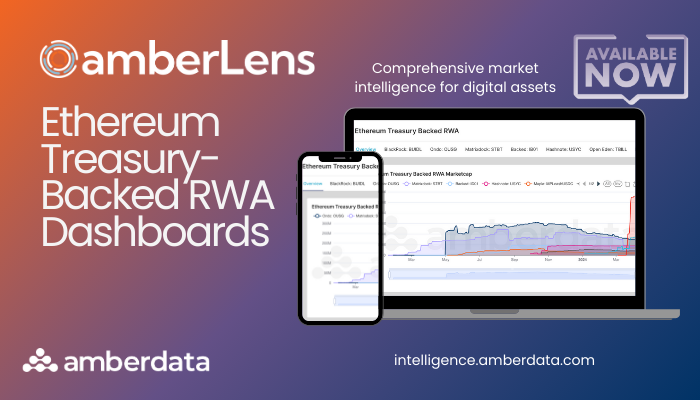AmberLens Product Update: Real-World Asset Tokenization Dashboards

Bringing real-world assets (RWAs) on-chain has long been a dream of the entire blockchain ecosystem, and 2024 looks to be the year that this dream is realized. Institutions are now integrating blockchain technology into their core strategies and philosophies, and Boston Consulting Group has predicted that asset tokenization could reach $16 trillion by 2030. There is no doubt that tokenization is poised to reshape the landscape of traditional investment practices, and many institutions are dipping their toe into distributed ledger technology via treasury-backed tokenized assets. Because tokenizing treasury securities like government bonds can generate yield with fewer risks than other strategies, many institutions are beginning to leverage RWA to diversify their portfolios and hedge against depegging risks of stablecoins.
AmberLens is Amberdata’s comprehensive institutional market intelligence platform with visibility into crypto markets, stablecoins, and ETFs. Amberdata is proud to announce the launch of a new Ethereum Treasury-Backed RWA dashboard on AmberLens. By offering daily updates on market cap and specific RWA assets and protocols, we are excited to give institutions a well-rounded view of the tokenization economy and facilitate the growth and transparency of treasury-backed real-world assets. AmberLens metrics are available via API, AWS S3, Snowflake, Google BigQuery, and Databricks.
If you would like to learn more about what RWA tokenization is, why it is important, and who is emerging in the space, read our RWA primer here.
Tracking Treasury-Backed RWA Market Capitalization
By tracking the market cap of the treasury-backed RWA protocol, we can start to understand how the entire segment is trending and which protocols are leading the way.
We can see in the chart above that there is one protocol that has seen a recent surge. This is BlackRock’s $BUIDL token.
Outside of tracking the total market cap across Ethereum, we can use on-chain data to give visibility into how many unique wallets are interacting with these protocols. Below, we can see the number of unique wallets holding assets of each protocol over time. While the total number of unique wallets may seem low, it is important to remember that these assets require Know Your Customer (KYC) processes, and minimum investments range from $100,000 to $5,000,000.
Individual Analyses of Protocols
AmberLens provides individual dashboards on each covered protocol to glean information on the protocols themselves as well as which wallets are the primary holders of these assets. Current coverage includes:
BlackRock: $BUIDL: The BlackRock USD Institutional Digital Liquidity Fund provides qualified investors with the opportunity to earn U.S. dollar yields by subscribing to the Fund. The fund invests 100% of the assets into US Treasury bill and repurchase agreements.
Ondo: $OUSG: OUSG is a token tailored to crypto market makers that provides liquid exposure to short-term US Treasuries with 24/7 stablecoin subscriptions and redemptions. The significant majority of this portfolio is currently in the BlackRock USD Institutional Digital Liquidity Fund ($BUIDL), with the remainder in BlackRock’s FedFund (TFDXX), bank deposits, and USDC for liquidity purposes.
Matrixdock: $STBT: Matrixdock STBT offers fully backed short-term treasury tokens. STBT is pegged 1:1 to the U.S. dollar and allows accredited investors exposure to the US treasury yields on-chain.
Backed: $IB01: IB01 offers accredited investors exposure to treasury bonds (0-1 year) through ERC20 tokens issued on the Ethereum blockchain. The IB01 token tracks the price of the iShares Treasury Bond 0-1 year UCITS ETF.
Hashnote: USYC: USYC allows investors the ability to earn short-term risk-free returns. Hashnote assets are deployed in reserve repo and some allocation to T-Bills to allow for maximum liquidity and minimum duration risk.
OpenEden: TBILL: TBILL provides investors with direct exposure to a pool of short-dated U.S. Treasury Bills (“U.S. T-Bills”) through the minting of the TBILL token, which is backed 1:1 by U.S. T-Bills and a small portion of U.S. Dollar (“USD”) held as reserves for liquidity purposes.
Maple: MPLcashUSDC: Maple provides yield sourced from US Treasury bills. The pool lends USDC to a standalone single-purpose vehicle established by Room40 Capital, which generates yield on permitted US government instruments.
Superstate: USTB: USTB offers investors exposure to short-duration Treasury Bills and Agency securities. USTBs objective is to seek current income as is consistent with liquidity and stability of principal, targeting returns in line with the federal funds rate.
The protocols that are issuing treasuries on-chain adhere to KYC compliance and require minimum deposits. Additionally, many of the smart contracts that control the tokens only allow users to transfer assets to whitelisted counterparties. With these checks in place, users of the token-backed treasuries benefit from increased settlement times, decreased counterparty risk, real-time observability, lower costs, improved efficiency, interoperability through the DeFi ecosystem, and exposure to a broader base of investors.
Looking Ahead
Overall, the data looks extremely bullish for the RWA market. In 2023 and into 2024, we have seen players bring new treasury-backed protocols on-chain at an increasingly fast pace. This entire segment of RWAs is just over a year old and it has already captured almost $600,000,000 in market cap. In addition to this early and rapid growth, we have large traditional finance institutions echoing this bullishness. Larry Fink has said that his vision of the future is likely to include the “tokenization of every financial instrument” and that the “next generation for markets will be the “tokenization of securities.”
As Amberdata continues to expand our AmberLens offering in real-world assets, we are excited to add more features and analytics that range from other RWA categories such as real estate, private credit, and luxury goods. Additionally, we will continue to monitor how these assets are being utilized across the entire crypto ecosystem.
Important Links
Amberdata
Amberdata is the leading provider of global financial infrastructure for digital assets. Our institutional-grade solutions deliver data, analytics and comprehensive tools and insights that empower financial institutions to research, trade, and manage risk and compliance in digital assets. Amberdata serves as a...
